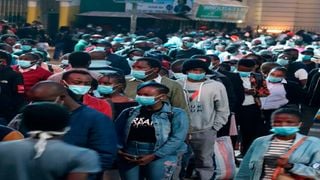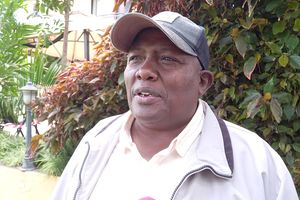
A winding queue of Nairobi residents waiting along Maragua Lane on April 14, 2021, for public service vehicles to ferry them to their estates before the 8pm curfew enforced to curb the spread of Covid-19.
| Dennis Onsongo | Nation Media GroupNews
Premium
Why Covid-19 fourth wave is yet to peak as predicted
What you need to know:
- Kemri had projected that by mid-July, the country would have recorded 4,300 new cases needing hospitalisation, and about 580 deaths.
Kenya’s fourth wave is yet to hit its peak as was predicted by the Kenya Medical Research Institute (Kemri), and experts cite under-reporting of Covid-19 data by the Health ministry as one reason for the low numbers.
Kemri had projected that by mid-July, the country would have recorded 4,300 new cases needing hospitalisation and about 580 deaths.
This was attributed to the existence of the highly transmissible Delta variant reported in western region.
As of Sunday, about 1,200 patients had been hospitalised in various parts of the country while 140 people had lost their lives due to Covid-19 between July 1 and July 18.
Experts now say under-reporting of data and vaccination uptake may have slowed down the curve that was to indicate a new wave.
A new wave, as consultant pathologist Ahmed Kalebi told the Nation yesterday, means that there is a sustained increase in the number of cases coming from a low point and going to a high peak.
When this is plotted on a graph and looked at overtime, it can be seen as the up and down movement of the positive numbers akin to any wave.
“The issue is mainly under-reporting of tests done and inadequate testing from a public health perspective. Incomplete collection and collation of Covid-19 test results by the Ministry of Health (MOH) from across the country as done by public and private medical facilities, whereby the results of Covid-19 tests done in these medical facilities are not relayed to MOH,” Dr Kalebi said.
“This is particularly so for the rapid antigen test, which can be easily procured and done literally by anyone, anywhere and anytime.”
Vaccination benefits
Infectious diseases expert Prof Matilu Mwau of the Kenya Medical Research Institute says the Covid-19 jab could have helped in slowing down the fourth wave.
“The country has vaccinated most of its health workers who are at high risk of getting Covid-19 and also transmitting it since they interact with many people. That has helped in containing the spread,” he said.
Kemri Deputy Director Matilu Mwau explains use of the Cobas 880 automated testing machine, which is capable of carrying out 2,000 Covid-19 tests and 3,000 HIV tests in a day, on April 7, 2020.
The Nation has learnt that some health workers conduct rapid antigen tests for Covid-19 but fail to report the data to the Health ministry.
“You just need to look at the fluctuation of daily cases per county to know that the data doesn’t make sense and point to lack of reporting coupled with lack of testing as the underlying reason,” Dr Kalebi said.
“Owing to the hustle of reporting test data and the stigma associated with positive results, many of these medical facilities would rather quietly do the rapid tests and act on it without reporting to MOH unlike in the early stages of the pandemic last year when MOH was closely controlling and monitoring the few labs that were authorised to undertake the PCR test.”
Dr Kalebi advised that the Health ministry in collaboration with county governments find new ways of incorporating all health facilities conducting tests to send data promptly so that Kenya can get the true picture of Covid-19.
“This might entail ways of MOH incentivising the medical community to report the data unlike the past situations where positive results were associated with stigma and even cumbersome attention on the reporting facilities,” he explained.
“The daily statistics from MOH further point to the underreporting when you find some counties going for days with zero cases then reporting tens of cases only to go back to no reporting, which makes no sense in terms of the fluctuation.”
The testing situation, he said, is driven by demand from travellers, clinical requests by doctors and the contacts of patients who can afford to take a test.
“There is very little if any testing being done at the community level for public health surveillance. If you compare the scale of testing in Kenya with that of say Rwanda and South Africa, you’ll see the per capita testing is way low in Kenya. This means we don’t have enough representation of what is going on in the community,” he explained.
While Prof Mwau said that Kenya has had about seven mini-peaks of Covid-19 surges since the onset of the pandemic, he said, the hardest-hitting wave being the third that peaked up around March this year.
New variants
The March wave was fuelled by the Alpha and Beta variants, which resulted in the closure of five counties in the Nairobi region.
“The mitigation measures actually saved the country from a rapid surge of a fourth wave as the delta variant was slowed down. That doesn’t mean it has gone away, and we are now seeing rising cases in Nairobi and Mombasa which are likely due to the Delta variant,” Dr Kalebi said.
Dr Ahmed Kalebi (right), a pathologist and CEO of Lancet Kenya, is pictured with his team at the lab, while explaining the process of testing for Covid-19, on April 22, 2020.
The Delta variant has affected 13 counties, all of which have been put under containment measures, with the Health Cabinet secretary reporting on Friday that the outcome was good.
“We have noticed that the people in Kisumu and its environs obliged to the containment measures and there has been a decrease in political activity and the number of people attending burials has been cut down. This has led to a decline in the positivity rate in that region,'' he said.
But Dr Kalebi insisted that testing and reporting accurate data will help in making sane decisions on Covid-19.
“Unfortunately, without adequate testing data we may not know the true extent of the ongoing surge until hospitals start getting overwhelmed and deaths spike as we are now seeing in areas like Mombasa and Kisumu, which hasn’t quite recovered,” he said.
“It is important for the MOH and medical facilities to step up testing and reporting of the test results to inform a better public health response. More importantly is to monitor the rate of hospitalisation and ensure that as hospitals get inundated by new admissions, the authorities are able to take proactive measures to break the cycle,” he added.





